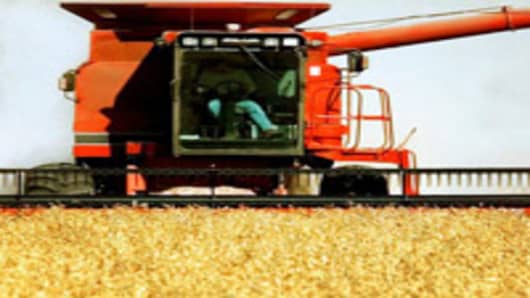Investors wondering whether the agricultural commodities bubble has burst will get some important clues in Monday's annual crop plantings report, considered a bellwether for the direction of farming activity for the year.
Analysts are looking for the Department of Agriculture's survey to show a substantial decrease in corn acreage over last year's record planting, as well as a pronounced increase in soybeans and more wheat in the ground.
But what those projections will mean for investors remains to be seen. Commodity analysts are expecting volatile planting numbers this year, with the weather and direction from traders to play a major role.
Wet conditions in the heartland, for instance, could depress the amount of corn acreage, raising its price in turn. Soybeans, meanwhile, likely will get more attention this year after losing acreage to corn in 2007 due to a sharp increase in demand for ethanol. Wheat also will be in flux, its price subject to possibly lower demand due to resumption of planting worldwide after a year of a supply-constricting global drought.
How the three major agricultural products fare is of major concern as investors wonder whether the commodity's bullish run of record-setting prices will continue or has run its course.
Run for Oil, Gold at Its End?
Other commodities, such as gold, platinum and oil also have seen record runs, but there is sentiment that the end may be near. The commodities run has been fueled by speculators and those cashing in on the weak dollar, the currency in which most commodities are traded.
"Planting intentions are very important to how our supply and demand balances will look this coming year," said Melvin Brees, an agricultural economist at the University of Missouri's Food and Agricultural Policy Research Institute. "One of a number of factors is the unpredictability of the weather."
Corn takes the biggest hit from bad weather, as it needs to be planted the earliest of the other major crops. It also does not plant well in saturated soil and requires the most fertilizer, which has become more expensive as the United States has lost its place as the world's primary manufacturer.
Continued rainy conditions, or an excessively wet spring, could alter the agricultural commodities market dramatically, sending corn prices well higher on less supply.
"That would create a huge amount of volatility in the markets," Brees said. "With supplies as they are, you would probably see a sharp market reaction."
With a record corn planting last year, there was a decent increase in carryover — the amount that's left over from the previous harvest — to the spring. But should corn production drop this year, that could make supplies very tight and become a bullish indicator for prices. The same thing goes for wheat and soybeans, both of which also saw low carryover rates, attributable to surging demand from emerging markets across the world.
Analyst estimates for this year's plantings vary significantly, from Brees' FAPRI estimate of 91.8 million acres of corn, above the average estimate of a little less than 88 million, which itself is well above last year's 93.6 million, the biggest planting in 60 years. FAPRI estimates 69.5 million for soybeans -- up considerably from last year's 61.7 million due to record prices for the crop -- but the range runs from 71.8 million to 69 million. Wheat has a smaller estimated range, from 61 million to 64 million.
There's a general feeling that this will be one of the toughest years to get an actual read on plantings until the USDA releases actual numbers in June.
"This is probably going to be the least accurate of any planting intentions survey," said Elaine Kub, an analyst at DTN consultants in Omaha, Neb. "There should be accuracy here, but this year they're just not going to be very accurate and there's nothing you can do about it.
"You ask somebody what they're going to do now, and that could entirely change depending on what the weather is going to be."
Still, few analysts are ready to call an end to the bull market in agriculture, despite looming volatility and prices that fell sharply downward last week.
"I would not call the long-term trend over by any means. This very recent weakness that we've seen was more a function of speculators getting washed out," Kub said. "The entire market is not a bubble. There was just a part of it that needed to get washed out. The fundamental trends ... they're still in place."


